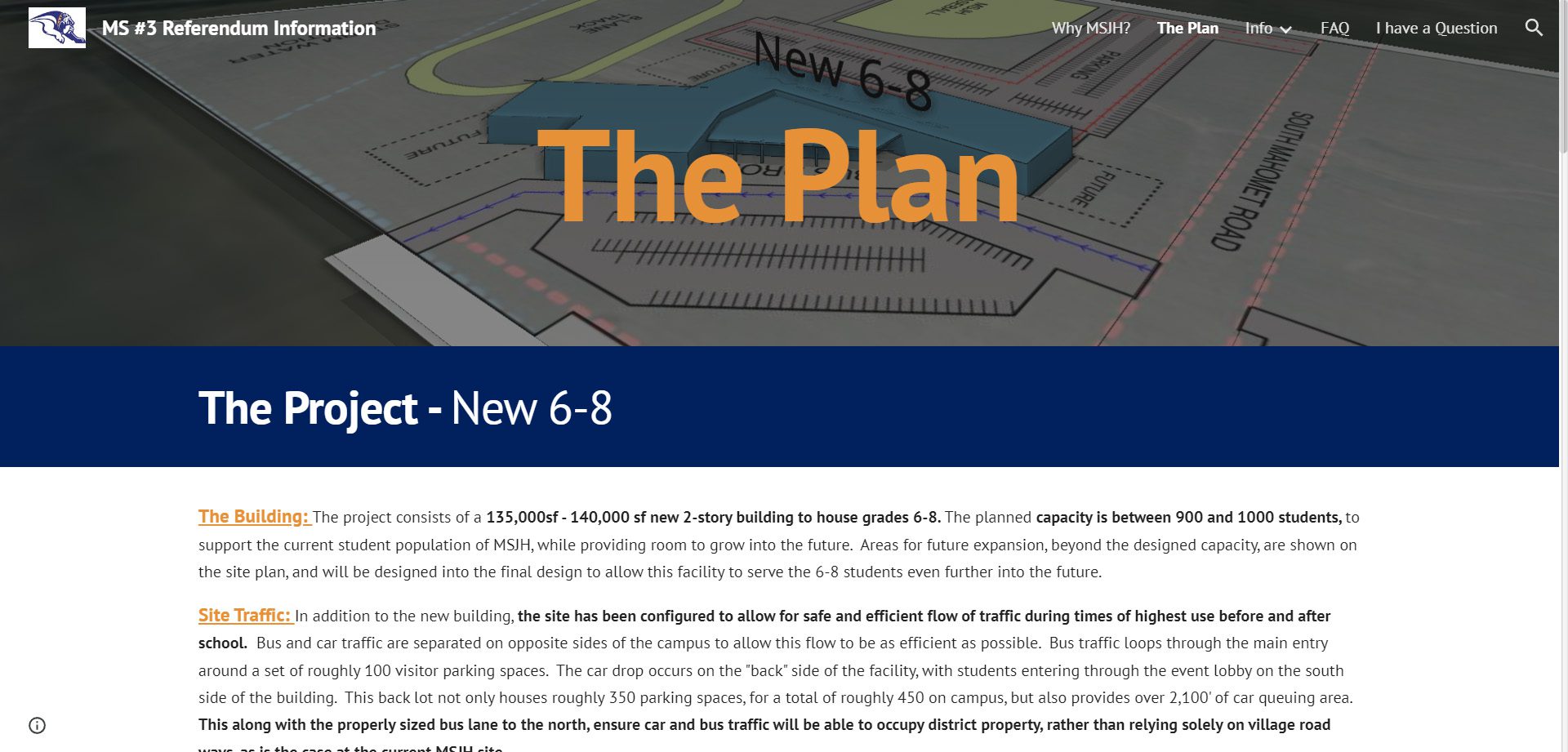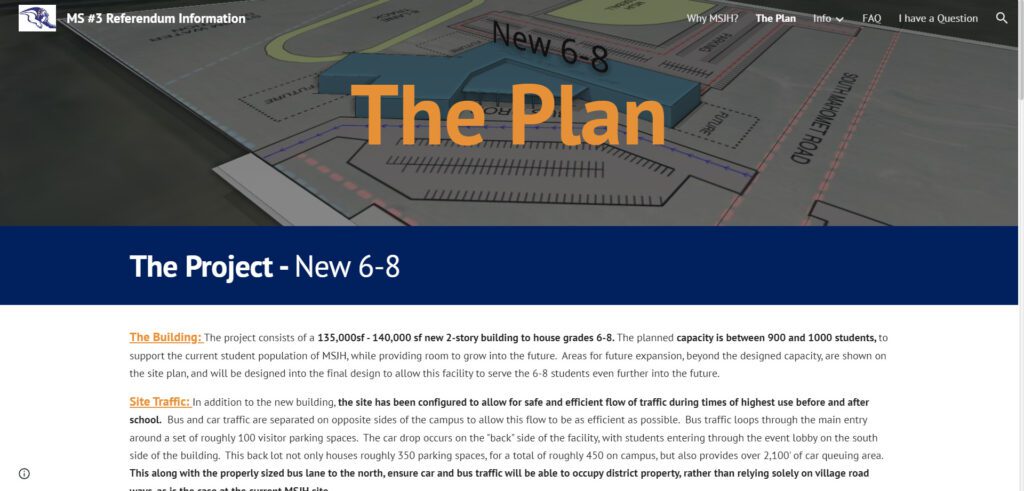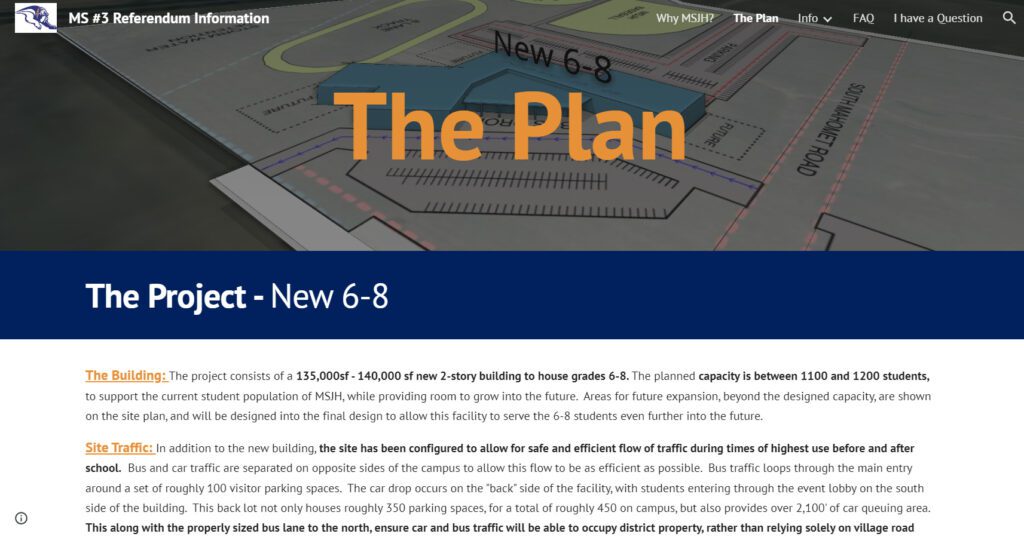Commentary: Did Mahomet-Seymour really just change the numbers?

By Dani Tietz
On Sunday night, I combed over an article about projections and capacity of enrollment at Mahomet-Seymour Junior High School that would be published on Monday morning. I have been collecting data for years, looking at enrollment numbers, classroom sizes, the number of classrooms, and then following information given to the Mahomet-Seymour community as the June 28 and Nov. 8 referendum dates approached.
With children that grew up in the Mahomet-Seymour School District, the topic was close to my heart. When my oldest daughter entered first grade at Sangamon Elementary her class had grown from 187 students in kindergarten to 201 students in first grade. By the time my middle daughter came to Sangamon, her class grew from 166 in kindergarten to 193 in first grade. And as my son’s class came to Sangamon, his class jumped from 180 in kindergarten to 202 in first grade. The girls’ graduating classes were 253 and 219, respectively. My son’s class is currently at 226 students enrolled.
In comparison, the current first-grade class has 248 students. The current senior class has 265 students and started kindergarten with 215 students.
How do I know this? Because I collect data. I am a journalist. I am recording history.
Journalism isn’t just about making sure that all of the stories get printed and all of the accolades are at the forefront. Journalism is so much more than that. Journalism’s first obligation is truth and its loyalty is to the citizens. Its job is to monitor power and its requirement is to maintain independence.
Firsthand, let me tell you that this is very hard to do.
Journalists are subject to the information presented to them, but their responsibility is to check the information presented.
In America, it has always been that the press serves as the fourth branch of government – one that is in place to serve the governed, not the governors.
In writing for the U.S. Supreme Court majority that decided in favor of the press during New York Times Co. v United States, Supreme Court Justice Hugo Black wrote, “In the First Amendment the Founding Fathers gave the free press the protection it must have to fulfill its essential role in our democracy. The press was to serve the governed, not the governors. The Government’s power to censor the press was abolished so that the press would remain forever free to censure the Government. The press was protected so that it could bare the secrets of government and inform the people. Only a free and unrestrained press can effectively expose deception in government.”
Not all journalists operate in this manner, though. For the most part, people in power love journalists that just come to meetings and regurgitate what is presented. And some journalists love to be loved, and so they take those talking points and run with them. They win awards with them. They get fed articles and ideas with them.
I certainly started off in the please-love-me phase.
But as I watched meeting after meeting, something seemed off. Was the public being given all the information it needs to make decisions about how to organize its life together? Or was there a piece of information here … then another piece somewhere else … and another piece somewhere else? Where is the whole picture?
This question has made me a better journalist. First, I understood that I needed to collect as much as I could to tell a whole story rather than this and that, here and there. I call this playing the long game. Second, I learned the ins and outs of investigative journalism, the art of asking questions and sending FOIA requests. Third, I knew that if I were to publish something that was outside of or more than what the community had been given, I needed to check and check and re-check my information before I published.
This brings us back to Sunday night. I sent the article off to my colleague, telling him that I know it goes against the grain, but the math is good and the public needs to know what’s happening with the referendum prior to the Nov. 8 vote. I remember thinking, “you need to take screenshots of everything under the Mahomet-Seymour Referendum and Bulldog Blueprint page because they could go in and change that information.” Then I thought, this information has been up, and talked about as the “facts” for almost a year, so why would they take it down or change it?
I watched my email inbox all day Monday after publishing. The only feedback I got was from the district architect, Damien Schlitt, who told me, “The figures that were utilized and calculated were from 2006/2007 – 2021. The average year-over-year growth during that time was 1.0%. There were 5 years with no growth or a decline in students during that window. Even if we look just since 2015 the last time enrollment dropped (2014) it’s a year-over-year average of 1.2%.”
I went back to the numbers used in the data for the article. The average growth was still 1.7%. “High growth” was still 2.9%. If growth continued at these rates, the district would still run out of space in the new junior high before the $59.4 was paid off in 20 years. It was not a statement. All it was is data that provided information that was contrary to what the district had told people. I took time to look at the numbers from all perspectives.
Schlitt said nothing about how the information about projections for planned or max capacity was incorrect. His only call for correction was the average percentage.
At that moment, I thought again about taking screenshots of the Bulldog Blueprint website. I thought, “you have those somewhere on a hard drive. And they won’t take them down.” I thought again about taking screenshots of the district website but thought, “the referendum page just went along with the Bulldog Blueprint information until about a month ago, and now they’ve updated it to exactly what they want the community to know: what are the pros and the cons (in their eyes); what are enrollment numbers; what do junior high teachers say; what is the planned and max capacity.” It was just updated in bold. When we put something in bold, we want people to concentrate on it. It’s purposeful.
In fact, the max capacity of the new building on this new site was 1,000, but I went with the max capacity on the Bulldog Blueprint site because it was more students, and that’s helpful for the Mahomet-Seymour taxpayers.
Then, on Tuesday afternoon as I’m just going about my workday, I get a message: “Your article about the referendum states the new building is designed for 900 to 1,000 students, but the referendum website states 1,100 to 1,200. I’m sure you found the 900 to 1,000 capacity somewhere. People seem to be commenting about the capacity being so small, but 1,100 to 1,200 is vastly different than 900 to 1,000.”
I had copied and pasted the two columns for old junior high school and new, but I didn’t have that screenshot that showed the information. So I clicked on “The Plan” and it still said 900-1,000. So I took a screenshot of that. Then I went to the Bulldog Blueprint site. However, where there was a site yesterday, there was no longer a Bulldog Blueprint site; it was taken down.
The person I was talking to told me around 2 p.m. that the website now had updated capacity numbers under the page “The Plan.” He watched it happen. For the same amount of money, $59.4, the district now says it will provide a building that is the same square footage as I reported, “a 135,000 square foot – 140,000 square foot new two-story building to house grades 6-8” but now, that building has a capacity of between 1,100 and 1,200 students.
Well, Mahomet-Seymour community, if my reporting has done anything for you, should the referendum pass, you will get a building that is not bigger, but has more capacity. Of course, we aren’t sure how an additional 200-300 students will fit into that space. Schlitt has not been forthcoming on how many classrooms will be allocated throughout this whole process. In fact, the website now says, “**New Capacity based upon architect developed space program configured to support 1100 – 1200 students within 135,000 sf – 140,000sf- further refinement to enrollment targets and program support to be completed through extensive collaboration with district administration, building administration, teachers and staff during the design process. This capacity expansion would support an additional three “sections” of each grade 6-8 from what is needed today as well as properly support the current students being served in undersized spaces. The project budget of $59.4M will support the capacity and programming needs of the district to allow this facility to support the district well into the future.”
Then I have questions: renovating Mahomet-Seymour Junior High to 135,000-140,000 added about 10 classrooms for a much lower dollar amount; I think it was around $20 million. How does adding room for more students not add to the cost of the project? How will the district afford additional teachers when we just heard during negotiations that the salary increases for current staff may cause the district to not hire teachers in the future? Is it safe to add more students to that space in terms of fire standards, etc.?
Did Mahomet-Seymour see its mistake in capacity after the article was published on Monday? In the middle of the night, did they say, “yes, Dani was right and we need to do better.”? Did anyone in the community receive notification of new and updated information allotting for this revelation? Did anyone in the community hear anything from the district? Or did they just go in and change the information without telling anyone so that the new data would potentially get the result they wanted? Did they just think, “if we change the capacity on the website, no one will be the wiser.”?
I love to think about how people get from point A to point B. Someone thought, “we’ll just do a little switcheroo and then the Mahomet Daily will look like the fool.” This is the story they’ve told in the community for ages: “the Mahomet Daily is divisive, pushes too hard, asks too many questions. Dani Tietz is just a nut with an agenda.”


The real problem for the district is that Dani Tietz just sees past the Jedi powers of gaslighting, manipulating, partial stories and data that empower developers, contractors, and real estate agents and puts the financial burden, the academic burden, and the civil burden onto the taxpayers and constituents of Mahomet-Seymour because she’s been watching and listening and reading for a decade.
I digress.
So let’s look at capacity with planned capacity at 1,100 and max at 1,200. It certainly buys taxpayers some time in their 20-year bond commitment. At high capacity, 2.9%, a new Mahomet-Seymour Junior High School would reach planned capacity (1,100) in 2033, and max capacity (1,200) in 2036. If enrollment increases by the average 1.7%, planned capacity will be reached in 2040, three years before the $59.4 bond is paid off and max capacity in 2046, three years after the bond is paid off.
In 2016, when the district was making plans for the Middletown Prairie Elementary addition and renovation, I sat with then-superintendent Rick Johnston and asked specific questions about the building’s capacity for community growth. I was told that the building had enough classrooms to adjust year-after-year to the community’s needs for each class. At only six years old, Middletown Prairie is close to being in the same boat as Lincoln Trail, busting at the seams.
In fact, Monday night, the board of education voted to approve leasing space in the building formerly known as Sangamon Elementary because they don’t have enough space for operations with the Technology Department at Middletown Prairie Elementary.
Looking at enrollment data and projections, seeing what was included in the projections and what is not even being considered (several developments that are unfinished, the Village plans for expansion and development, what may or may not happen in Champaign Unit 4 schools) is only going to leave Mahomet-Seymour taxpayers in the same boat. The data shows that whether the capacity is at 1.7% or 2.9%, even if it is at 1%, which is unlikely unless something catastrophic happens, the proposed building will reach capacity more quickly than taxpayers were told. We also know from discussion among board members and staff that a $59.4 million building does not even begin to touch capacity issues in other facilities within the district.
Why did they have to take the Bulldog Blueprint site down and change what is on the referendum page of mahometseymour.org? Because the words they said did not match the data they presented. It just took someone who wanted to take the time, to have years and years of data, to analyze that data to show that the story did not equal reality.
My loyalty has always been to the taxpayer and constituents in the way that I tell stories. My commitment has always been to dig beneath the surface of information to find the truth. I will admit that I do not have all the answers to how or why things happen the way that they do. But what I do know is that people who are represented by a taxing body deserve complete and accurate information.
They also deserve leadership that tells the truth, even when that message is hard. Leadership that proves its focus is on the kids and the community, not by the words they choose or the narrative they spin, but with the votes they take and the priorities they set.
As I was doing research on development last spring, I sat down with Village Planner Kelly Pfeifer to ask about the thousands of pages of emails I obtained through FOIA. At the end of the conversation, I explained myself in comparison to the assumption that I’m just out to get people.
I have never cared if the Mahomet-Seymour community grows. I no longer live there, but I miss the love I found in that town. I want other people to experience the goodness I found there: the great park system, the quiet of the Sangamon River, the magic of the trees in October, and the people who make the day magical with an invitation to lunch.
Honestly, if the majority of the community votes to approve $59.4 million to build a new junior high, then that’s what the community has decided.
Something, at some point, needs to be done. I have been talking about capacity for about a decade now. But I would feel terrible if I just gave you the talking points, much like I did with Middletown Prairie, without asking questions and looking deeper so that everyone has access to adequate information to make their decision without pretense.
I literally have nothing to gain from this. And the way Mahomet works, I actually have everything to lose.
So, let me be straight with you: what I have always cared about and will always care about is honesty, transparency, and priorities. I care that people get the information they deserve so that they can make informed and educated decisions about the way they choose to live their lives. I care that people are taken care of and that they have what they need and deserve as human beings. I care that governments are forward-thinking, that they live within their means, and that they provide infrastructure for their visions and goals. Over the years I have learned that community means a hundred different things to a hundred different people, but I care deeply about community.
I don’t even care if the community takes this instance into consideration. What I do hope, though, is that the community looks at the information presented in the future and says, what more is there? Am I being told everything I need at this moment? Who is telling me this information? What do they have to gain through this information? Where can I get more information? Apply this to all parts of your life.
I guess the question for me today is, what does it mean to live in a community where information is given in hopes of an outcome that will benefit a few and then taken down or changed when the data doesn’t back up the narrative? I’m not surprised by much anymore, but I am shocked that Mahomet-Seymour is this type of community.



